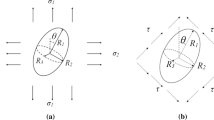Abstract
On the bases of recent achievements on the micro-mechanism of cleavage this paper analyses the inherent deficiencies of the stress intensity factor K I which is used to evaluate the fracture toughness of quasi-brittle and micro-inhomogeneous materials. The K I parameter can uniquely determine the field intensity ahead of a crack tip in the condition of elastic and small scale yielding (SSY). However, the K I cannot uniquely determine the critical condition triggering the cleavage fracture in a quasi-brittle and inhomogeneous steel where the cleavage fracture process is not a direct extension of the precrack but is initiated at a variable distance from the precrack tip. The variable distances of cleavage initiations invoke varied critical values of K I. On the bases of authors' experiments, this paper analyses the physical meaning of the local fracture stress σf, its stability and the feasibility to be used as an engineering parameter for assessing the fracture toughness.
Similar content being viewed by others
References
Beremin, F.M. (1983). Local Criterion for cleavage fracture of a nuclear pressure vessel steel, Metallallurgical Transactions 14A, 2277-2287.
Chen, J.H., Zhu, L. and Ma, H. (1990a). On the scattering of the local fracture stress σ f, Acta Metallurgica Materialia 38, 2527-2535.
Chen, J.H., Wang, G.Z. and Ma, H. (1990b). Fracture behavior of C-Mn steel and weld metal in notched and precracked specimens: Part II Micromechanism of fracture, Metallurgical Transactions 21A, 321-330.
Chen, J.H., Ma, H. and Wang, G.Z. (1990c). Fracture behavior of C-Mn steel and weld metal in notched and precracked specimens: Part I Fracture behavior, Metallurgical Transactions 21A, 313-320.
Chen, J.H., Wang, G.Z., Wang, Z., Zhu, L. and Gao, Y.Y. (1991). Further study on the scattering of the local fracture stress and allied toughness valued, Metallurgical Transactions 22A, 2287-2296.
Chen, J.H. and Wang, G.Z. (1992). Study of mechanism of cleavage fracture at low temperature, Metallurgical Transactions 23A, 509-517.
Chen, J.H., Zhu, L., Wang, G.Z., and Wang, Z. (1993). Further investigation of the critical events in cleavage fracture of C-Mn base and weld steel, Metallurgical Transactions 24A, 659-667.
Chen, J.H., Yan, C. and Sun, J. (1994). Further study on the mechanism of cleavage fracture at low temperature, Acta Metallurgical et Materialia 43, 251-261.
Chen, J.H., Wang, G.Z. and Wang, H.J. (1996a). A statistical model for cleavage fracture of low alloy steel, Acta Materialia 44, 3979-3989.
Chen, J.H. Hu, X.J. and Wang, G.Z. (1996b). The local fracture stress σ f as a fracture toughness parameter characterize an heterogeneous weld zone, Fatigue Fracture Engineering Materials and Structure 19, 807-819.
Chen, J.H., Wang, G.Z., Yan, C., Ma, H. and Zhu, L. (1997a). Advances in the mechanism of cleavage fracture of low alloy steel at low temperature, Part I: Critical event, International Journal of Fracture 83, 105-120.
Chen, J.H., Wang, G.Z., Yan, C., Ma, H. and Zhu, L. (1997b). Advances in the mechanism of cleavage fracture of low alloy steel at low temperature, Part II: Fracture model, International Journal of Fracture 83, 121-138.
Chen, J.H., Wang, G.Z., Yan, C., Ma, H. and Zhu, L. (1997c). Advances in the mechanism of cleavage fracture of low alloy steel at low temperature, Part III: Local fracture stress σ f, International Journal of Fracture 83, 139-157.
Chen, J.H. and Wang, G.Z. (1998a). On scattering of measured values of fracture toughness parameters, International Journal of Fracture 94, 33-49.
Curry, D.A. (1980). Cleavage micromechanisms of crack extension in steels, Metal Science, 319-326.
Griffith, A.A. (1920). The phenomena of rupture and flow in solid, Phil. Trans. Roy. Soc. London. A221: 163-198.
Griffiths, J.R. and Owen, D.R.J. (1971). An elastic-plastic stress analysis for a notched bar in plane strain bending, Journal of the Mechanics and Physics of Solids 19, 419-431.
Goodier, J.N. (1968). Mathematical theory of equilibrium cracks, Fracture Vol II 17, Academic Press New York, 2-66.
Irwin, G.R. (1957). Relation of stress near a crack to the crack extension force, Proc. 9th Inter. Congr. Appl. Mech. VIII, 245-251, University of Brussels.
Knott, J.F. (1973). Fundamental of fracture mechanics, The Butterworth Group.
Li, J.N. (1998). Dissertation for master degree, Gansu University of Technology.
Lin, T., Evans, A.G. and Ritchie, R.O., (1986). A statistical model of brittle fracture by transgranular cleavage, Journal of the Mechanics and Physics of Solids, 34, 477-497.
McMeeKIng, R.M. (1977). Finite deformation analysis of crack-tip opening in elastic-plastic materials and implications for fracture, Journal of Mechanics and Physics 25, 357-381.
Orowan, E. (1945). Notch brittleness and the strength of metals, Trans. Inst. Engrs Shipbuilders Scotland, 89, 165-215.
Rice, J.R. (1968). A path independent integral and the approximate analysis of strain concentrationby notches and cracks, Journal of Applied Mechanics 35, 379-386.
Rice, J.R. and Johnson, M.A. (1970). The role of large crack tip geometry change in plane strain fracture, Inelastic behavior of Solids, McGraw-Hill, New York, 641-671.
Ritchie, R.O., Knott, J.F. and Rice, J.R. (1973). On the relationship between critical tensile stress and fracture toughness in mild steel, Journal of the Mechanics and Physics of Solids 21, 395-410.
Wall, M., Lane, C.E. and Hippsley, C.A. (1994). Fracture criteria for hydrogen and temper embrittlement in 9Cr1Mo steel, Acta Metallurgica Materialia 42, 1295-1309.
Wallin, K., Saario, T. and Torronen, K. (1984). Statistical model for carbide induced brittle fracture in steel, Metal Science 18, 13-16.
Wang, G.Z. Wang, H.J. and Chen, J.H. (1998). Effects of notch geometry on the local cleavage fracture stress σ f, Fatigue Fracture of Engineering Materials and Structure, 22, 849-858.
Wells, A.A. (1963). Application of fracture mechanics at and beyond general yielding, British Welding Journal 11, 563-570.
Yan, C., Chen, J.H., Sun, J., and Wang, Z. (1993). Critical assessment of local cleavage stress σ f in notched specimens of C-Mn steel, Metallurgical Transactions 24A, 1381-1389.
Author information
Authors and Affiliations
Rights and permissions
About this article
Cite this article
Chen, J., Wang, G. Study on cleavage fracture criteria of the quasi-brittle and micro-inhomogeneous materials. International Journal of Fracture 108, 143–164 (2001). https://doi.org/10.1023/A:1007614505509
Issue Date:
DOI: https://doi.org/10.1023/A:1007614505509




